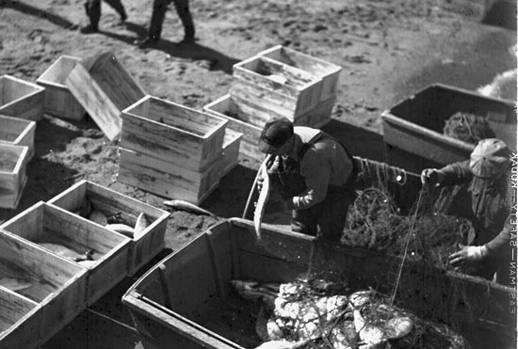Dear Jeff, Great to see you at Port Eliot. Congratulations to the folk involved, a brilliant effort. I came back with your ‘this years Jeff tip’ the Dr John album, and it will be played much this week.
This is the piece that I found on my bicycle ride up the Hudson valley a few weeks ago. I thought that you might like it. The river is incredible and was almost completely polluted by pcbs in the 50s andy 60s put into the river by General Electric, bizarrely their plant at Hudson Falls is now called the Hudson Environmental research station. Pete Seeger’s efforts to clean up the river (with his Clearwater project) have been brilliant and the highlight was seeing him on stage (with Tom Paxton and Janis Ian) for a celebration of Woody Guthries 100th year anniversary . He is 93.
 Shad fishermen on the Hudson, 1945
Shad fishermen on the Hudson, 1945
Fishing in the Palisades on the Hudson by a man called William O. Allison, who was born in 1849 and wrote this in 1913:
‘Looking up at the small dilapidated abiding places along the Palisades in 1913, one could hardly help smiling when told how an ancestor refused to live in an isolated old house at Manhattanville (today the neighbourhood around West 125th street), because it was so lonely there and requested that they move their home across the river under the Palisades, where they would have neighbors.
There were probably few places in this or any other county, where so good a living could be obtained with so little effort. The River, until it became polluted, teemed with fish of every sort, and the shad fishing during some six weeks in the Spring was profitable enough to support a family for the year. At low tide, the soft clams could be dug, and the oysters beds on the west side of the river could be raked and tonged. It was a common thing, any still summer day, to observe a shark swimming near the surface. Porpoises were plentiful, and the huge sturgeon would call attention to his frolic by jumping his full length out of the water, and falling back.
The catching of Shad was by using poles sunk into the deep water and mud across the tide. The poles of oak or hickory would be 45-50ft long. On each pole was a strong hoop, made of hickory sapling, with a stone fastened to it weighing perhaps 25 pounds. The nets were lifted every six hours, at the slackening of each tide, called the ebb lift and the flood lift. The best fishing was on the flood tide, as the shad were going up to fresh water to spawn and the great catches were when they had a full moon, and big flood tides. It was no uncommon thing for a boat to bring in 500 shad from one lift, and often take 1000 in 24 hours. The fishermen made an arrangement with a merchant in New York, to sell their fish, usually for 1 cent a piece, and in the 1860s. Sturgeon were an annoyance as they were so big they broke the nets. Besides striped bass, smelts and eels from from the salt water, there would be goldfish, sunfish, pike, pickerel, suckers, catfish, etc from the freshwater’.
—————————————————————————————————————————————
This article was given to us by our friend Nick Hand. I had a root around on the web to see if I could find anything out about William O. Allison, the author, and I discovered that this is an edit from an unfinished book he was writing about his boyhood life on the Palisades. Further reading can be found on the Palisades Interstate Park website here.